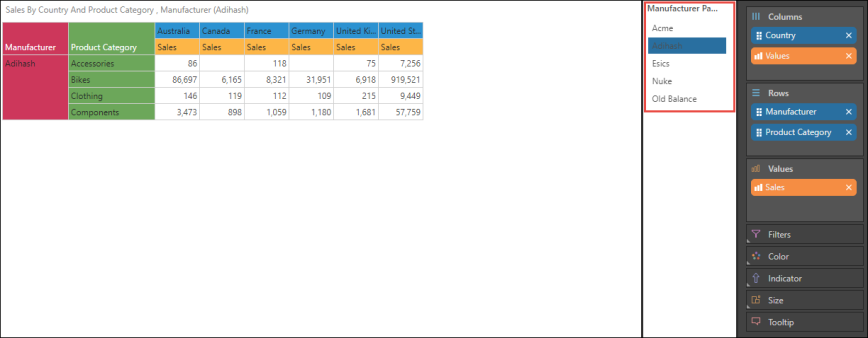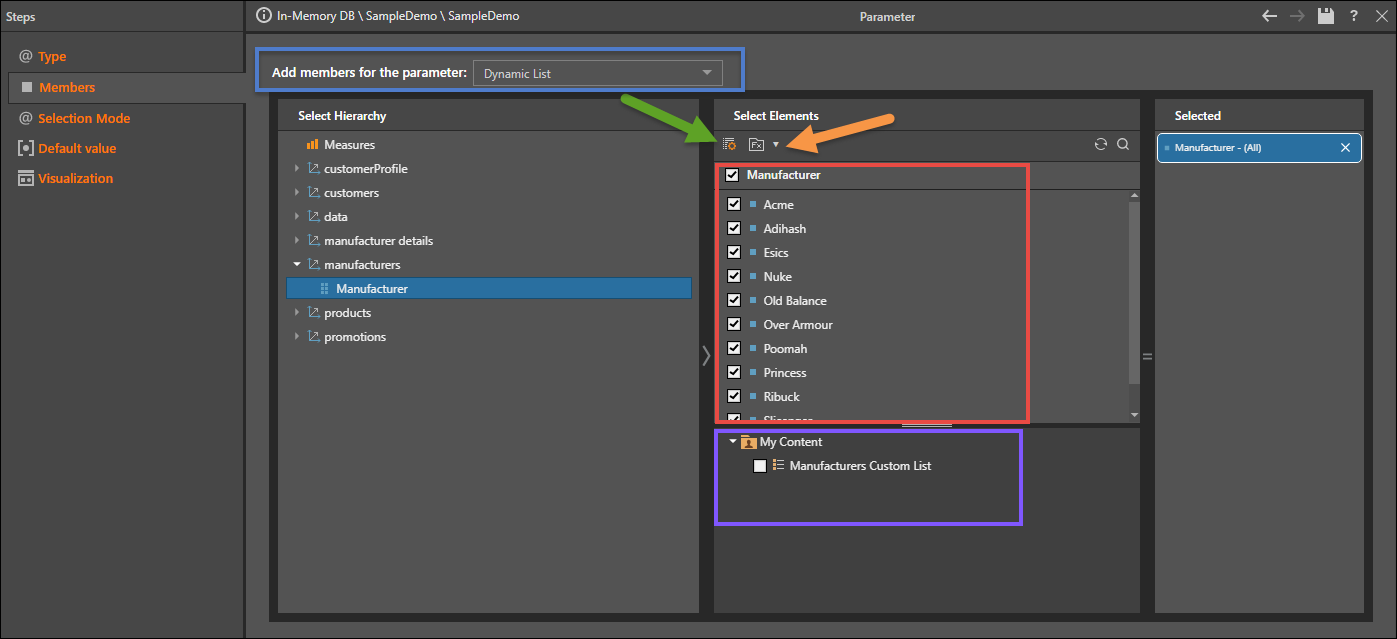Model Parameters
Model parameters are configured on a given data model, and as such may be accessed and used only when querying that model. This is in contrast to global parameters, which are not bound to any data model, and can therefore be used across servers and models.
Like global parameters, users can create both numeric and text model parameters. Unlike global parameters, model parameters provide the ability to create Dynamic List text parameters. Parameters based on a dynamic list (as opposed to a static discrete list) do not require further configuration in order to be used in queries, as the user supplies the values from the data model when building the parameter.
In the screenshot below, the parameter is based on the Manufacturer hierarchy, so each slicer option is an element from within that hierarchy (a manufacturer).

Model Parameter Ribbon
Run Button: click the Pyramid run button to test your parameter.
Refresh Metadata: refresh the data model metadata, including dimensions, elements, and business logic.
Quick Discovery: click to open the KPI Discover. Click here for more information.
Quick Logic: open build a formula, list, KPI, or parameter in a new tab.

Model Parameter Steps
Parameters can be created from Discover using the quick calculations functionality - click here to learn how to build quick parameters.
Type

Members
From members, add the required text elements to the parameter. Start by selecting either dynamic list or discrete list from the drop down (blue highlight below).
Dynamic List
Choose dynamic list to build a parameter based on a list of dynamic elements. This dynamic list may be elements from a member hierarchy in the model, measures, member lists, custom lists, or other text parameters.
To create a dynamic list text parameter, select the required hierarchy from the Select Hierarchy panel.
From the Select Elements panel, there are a few options:
- Choose the elements that should be included in the parameter (red highlight)
- Click the List Builder icon to import a list of elements (green arrow)
- Click the Fx business logic button (orange arrow) to expose existing text parameters and custom lists (purple highlight)

Discrete List
- Custom lists using the Switch node
- Custom formulas using the Textual Parameter node
- Variable Lists in Discover
To build a discrete list text parameter, use the plus sign to add the required amount of list options. In the Value column, enter the text value (this is any text that you define). In the Caption column, enter the caption that should be displayed for each value in the resulting parameter slicer.
Selection Mode

Default Value
Select the parameter member that should be the default parameter value in the query. This is the value that will be selected by default, before you make a selection from the slicer.

Visualization
Choose the required slicer visualization. The visualization can be changed by editing the slicer from Discover, or by editing the parameter itself.

Add a Model Parameter to a Query
You can click Quick Discovery to open your saved parameter in Discover immediately.
To add your parameter to a query later on:
- Open a data discovery using the same data model that was used to build the parameter
- In the Dimensions panel, find the hierarchy that your parameter was based on. Right click on the hierarchy and click View Elements
- At the top of the Elements panel, click the Fx button

- Find and select the parameter from the folder tree
Edit a Parameter
To edit a parameter, find it in the Content Explorer. Click its context menu and choose Open - the parameter will be opened in Formulate, where you can edit it.
You can also edit a parameter slicer in your data discovery:
- Add the parameter to the query
- Click the context menu (3 ellipses) to open the Slicer Settings dialog, where you can change the title and visualization type
Note that editing a parameter slicer from Discover does not affect the parameter itself. To edit the parameter, open it in Formulate.